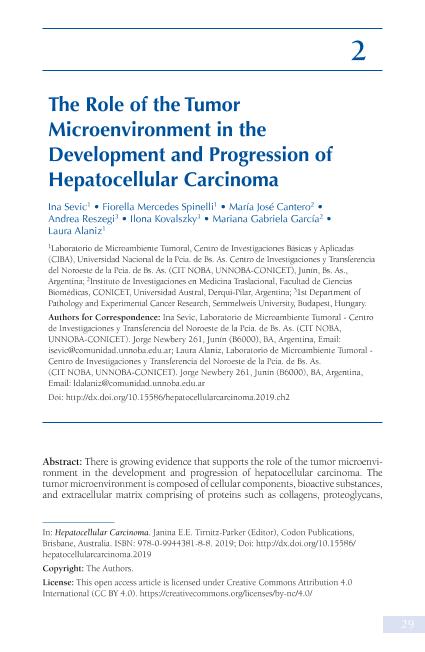Capítulo de Libro
The Role of the Tumor Microenvironment in the Development and Progression of Hepatocellular Carcinoma
Título del libro: Hepatocellular Carcinoma
Sevic, Ina ; Spinelli, Fiorella Mercedes
; Spinelli, Fiorella Mercedes ; Cantero, María José
; Cantero, María José ; Reszegi, Andrea; Kovalszky, Ilona; García, Mariana Gabriela
; Reszegi, Andrea; Kovalszky, Ilona; García, Mariana Gabriela ; Alaniz, Laura Daniela
; Alaniz, Laura Daniela
 ; Spinelli, Fiorella Mercedes
; Spinelli, Fiorella Mercedes ; Cantero, María José
; Cantero, María José ; Reszegi, Andrea; Kovalszky, Ilona; García, Mariana Gabriela
; Reszegi, Andrea; Kovalszky, Ilona; García, Mariana Gabriela ; Alaniz, Laura Daniela
; Alaniz, Laura Daniela
Fecha de publicación:
2019
Editorial:
Codon Publications
ISBN:
978-0-9944381-8-8
Idioma:
Inglés
Clasificación temática:
Resumen
There is a growing evidence that supports the role of the tumor microenvironment (TME) in the development and progression of cancer. TME is composed of cellular components, bioactive substances (e.g. growth factors) and extracellular matrix (ECM) comprising of proteins such as collagens, proteoglycans and the linear glycosaminoglycan hyaluronan, which is a key component of ECM. Hepatocellular carcinoma (HCC), generally arises from fibrotic or cirrhotic liver, characterized by excessive expression and alteration of ECM components which facilitates tumor development. On the other hand, non-tumoral cells, as such as the mesenchymal stem/stromal cells (MSCs) are typically recruited to the injured or hypoxic area within the tumor. Besides the secretion of immunoregulatory, growth factors and cytokines, MSCs and hepatic stellate cells (HSCs) can also synthesize hyaluronan, amongst other components, that affects several tumor processes. The TME also contains different types of immune cells. A key component in tumorigenesis in HCC are the macrophages, as tumor-associated macrophages (TAM). This chapter will describe specific data regarding the interaction of MSCs-hyaluronan-TAMs and tumor cells and how this interaction potentially contributes to the development and progression of HCC.
Palabras clave:
Hepatocellular Carcinoma
,
Hyaluronan
,
Tumor microenvironment
Archivos asociados
Licencia
Identificadores
Colecciones
Capítulos de libros(SEDE CENTRAL)
Capítulos de libros de SEDE CENTRAL
Capítulos de libros de SEDE CENTRAL
Citación
Sevic, Ina; Spinelli, Fiorella Mercedes; Cantero, María José; Reszegi, Andrea; Kovalszky, Ilona; et al.; The Role of the Tumor Microenvironment in the Development and Progression of Hepatocellular Carcinoma; Codon Publications; 2019; 29-45
Compartir



